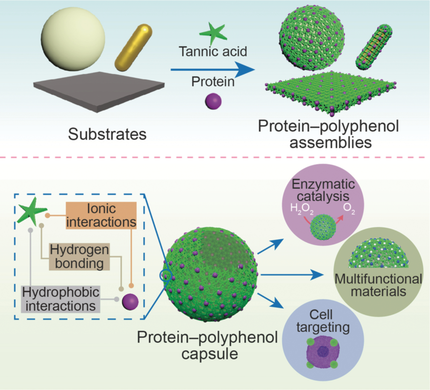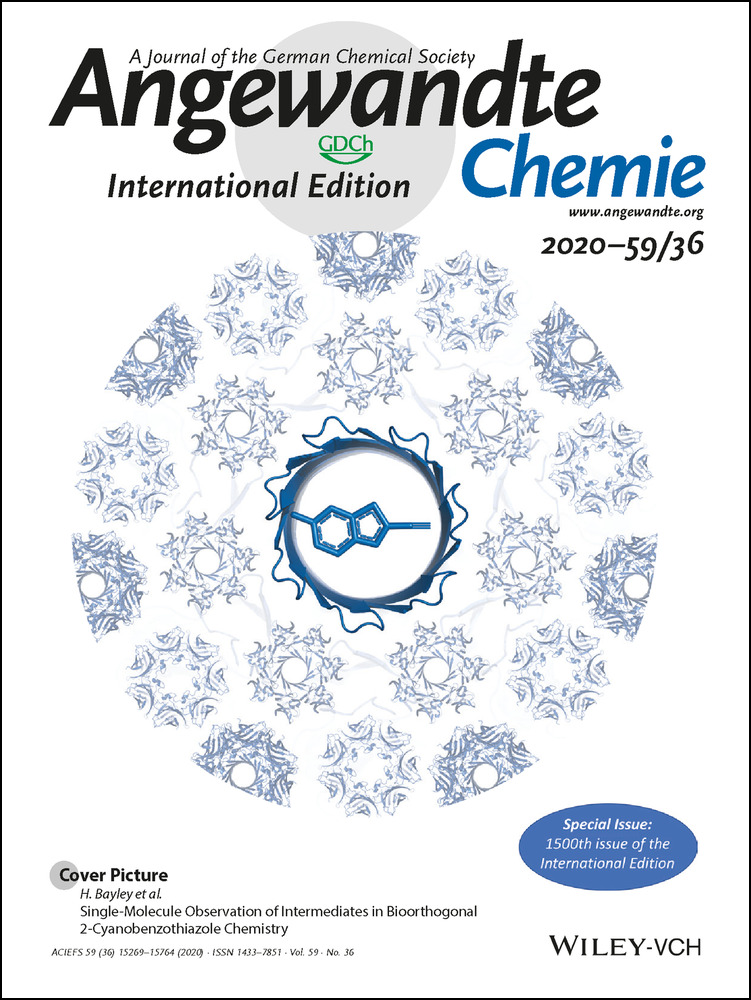Polyphenol-Mediated Assembly of Proteins for Engineering Functional Materials
Yiyuan Han
ARC Centre of Excellence in Convergent Bio-Nano Science and Technology, Department of Chemical Engineering, The University of Melbourne, Parkville, Victoria, 3010 Australia
Search for more papers by this authorZhixing Lin
ARC Centre of Excellence in Convergent Bio-Nano Science and Technology, Department of Chemical Engineering, The University of Melbourne, Parkville, Victoria, 3010 Australia
Search for more papers by this authorDr. Jiajing Zhou
ARC Centre of Excellence in Convergent Bio-Nano Science and Technology, Department of Chemical Engineering, The University of Melbourne, Parkville, Victoria, 3010 Australia
Search for more papers by this authorDr. Gyeongwon Yun
ARC Centre of Excellence in Convergent Bio-Nano Science and Technology, Department of Chemical Engineering, The University of Melbourne, Parkville, Victoria, 3010 Australia
Search for more papers by this authorRui Guo
ARC Centre of Excellence in Convergent Bio-Nano Science and Technology, Department of Chemical Engineering, The University of Melbourne, Parkville, Victoria, 3010 Australia
Search for more papers by this authorDr. Joseph J. Richardson
ARC Centre of Excellence in Convergent Bio-Nano Science and Technology, Department of Chemical Engineering, The University of Melbourne, Parkville, Victoria, 3010 Australia
Search for more papers by this authorCorresponding Author
Prof. Frank Caruso
ARC Centre of Excellence in Convergent Bio-Nano Science and Technology, Department of Chemical Engineering, The University of Melbourne, Parkville, Victoria, 3010 Australia
Search for more papers by this authorYiyuan Han
ARC Centre of Excellence in Convergent Bio-Nano Science and Technology, Department of Chemical Engineering, The University of Melbourne, Parkville, Victoria, 3010 Australia
Search for more papers by this authorZhixing Lin
ARC Centre of Excellence in Convergent Bio-Nano Science and Technology, Department of Chemical Engineering, The University of Melbourne, Parkville, Victoria, 3010 Australia
Search for more papers by this authorDr. Jiajing Zhou
ARC Centre of Excellence in Convergent Bio-Nano Science and Technology, Department of Chemical Engineering, The University of Melbourne, Parkville, Victoria, 3010 Australia
Search for more papers by this authorDr. Gyeongwon Yun
ARC Centre of Excellence in Convergent Bio-Nano Science and Technology, Department of Chemical Engineering, The University of Melbourne, Parkville, Victoria, 3010 Australia
Search for more papers by this authorRui Guo
ARC Centre of Excellence in Convergent Bio-Nano Science and Technology, Department of Chemical Engineering, The University of Melbourne, Parkville, Victoria, 3010 Australia
Search for more papers by this authorDr. Joseph J. Richardson
ARC Centre of Excellence in Convergent Bio-Nano Science and Technology, Department of Chemical Engineering, The University of Melbourne, Parkville, Victoria, 3010 Australia
Search for more papers by this authorCorresponding Author
Prof. Frank Caruso
ARC Centre of Excellence in Convergent Bio-Nano Science and Technology, Department of Chemical Engineering, The University of Melbourne, Parkville, Victoria, 3010 Australia
Search for more papers by this authorGraphical Abstract
In a material world: A simple and versatile strategy for assembling functional materials was established through the interfacial assembly of proteins and polyphenols on various substrates. Protein–polyphenol capsules were used to elucidate the dominant interaction(s) between different proteins and polyphenols. The assembled proteins retain their structure and function, thereby enabling their use in various applications, for example, biocatalysis or cell targeting.
Abstract
Functional materials composed of proteins have attracted much interest owing to the inherent and diverse functionality of proteins. However, establishing general techniques for assembling proteins into nanomaterials is challenging owing to the complex physicochemical nature and potential denaturation of proteins. Here, a simple, versatile strategy is introduced to fabricate functional protein assemblies through the interfacial assembly of proteins and polyphenols (e.g., tannic acid) on various substrates (organic, inorganic, and biological). The dominant interactions (hydrogen-bonding, hydrophobic, and ionic) between the proteins and tannic acid were elucidated; most proteins undergo multiple noncovalent stabilizing interactions with polyphenols, which can be used to engineer responsiveness into the assemblies. The proteins retain their structure and function within the assemblies, thereby enabling their use in various applications (e.g., catalysis, fluorescence imaging, and cell targeting).
Conflict of interest
The authors declare no conflict of interest.
Supporting Information
As a service to our authors and readers, this journal provides supporting information supplied by the authors. Such materials are peer reviewed and may be re-organized for online delivery, but are not copy-edited or typeset. Technical support issues arising from supporting information (other than missing files) should be addressed to the authors.
| Filename | Description |
|---|---|
| anie202002089-sup-0001-misc_information.pdf2.8 MB | Supplementary |
Please note: The publisher is not responsible for the content or functionality of any supporting information supplied by the authors. Any queries (other than missing content) should be directed to the corresponding author for the article.
References
- 1
- 1aH. Ejima, J. J. Richardson, K. Liang, J. P. Best, M. P. van Koeverden, G. K. Such, J. Cui, F. Caruso, Science 2013, 341, 154–157;
- 1bJ. Guo, B. L. Tardy, A. J. Christofferson, Y. Dai, J. J. Richardson, W. Zhu, M. Hu, Y. Ju, J. Cui, R. R. Dagastine, I. Yarovsky, F. Caruso, Nat. Nanotechnol. 2016, 11, 1105–1111.
- 2
- 2aJ. A. Shadish, G. M. Benuska, C. A. DeForest, Nat. Mater. 2019, 18, 1005–1014;
- 2bC. D. Spicer, C. Jumeaux, B. Gupta, M. M. Stevens, Chem. Soc. Rev. 2018, 47, 3574–3620.
- 3
- 3aX. Huang, M. Li, D. C. Green, D. S. Williams, A. J. Patil, S. Mann, Nat. Commun. 2013, 4, 2239;
- 3bQ. Luo, C. Hou, Y. Bai, R. Wang, J. Liu, Chem. Rev. 2016, 116, 13571–13632;
- 3cT. P. Knowles, T. W. Oppenheim, A. K. Buell, D. Y. Chirgadze, M. E. Welland, Nat. Nanotechnol. 2010, 5, 204–207.
- 4R. Liu, J. Zhao, Q. Han, X. Hu, D. Wang, X. Zhang, P. Yang, Adv. Mater. 2018, 30, 1802851.
- 5E. V. Skorb, D. V. Andreeva, Adv. Funct. Mater. 2013, 23, 4483–4506.
- 6
- 6aM. A. Rahim, S. L. Kristufek, S. Pan, J. J. Richardson, F. Caruso, Angew. Chem. Int. Ed. 2019, 58, 1904–1927; Angew. Chem. 2019, 131, 1920–1945;
- 6bJ. E. Chung, S. Tan, S. J. Gao, N. Yongvongsoontorn, S. H. Kim, J. H. Lee, H. S. Choi, H. Yano, L. Zhuo, M. Kurisawa, J. Y. Ying, Nat. Nanotechnol. 2014, 9, 907–912.
- 7S. Quideau, D. Deffieux, C. Douat-Casassus, L. Pouysegu, Angew. Chem. Int. Ed. 2011, 50, 586–621; Angew. Chem. 2011, 123, 610–646.
- 8F. Caruso, R. A. Caruso, H. Möhwald, Science 1998, 282, 1111–1114.
- 9
- 9aU. Shimanovich, G. J. Bernardes, T. P. Knowles, A. Cavaco-Paulo, Chem. Soc. Rev. 2014, 43, 1361–1371;
- 9bM. Yan, J. Du, Z. Gu, M. Liang, Y. Hu, W. Zhang, S. Priceman, L. Wu, Z. H. Zhou, Z. Liu, Nat. Nanotechnol. 2010, 5, 48–53.
- 10
- 10aP. Bandyopadhyay, A. K. Ghosh, C. Ghosh, Food Funct. 2012, 3, 592–605;
- 10bA. Papadopoulou, R. J. Green, R. A. Frazier, J. Agric. Food Chem. 2005, 53, 158–163.
- 11
- 11aM. Shin, H.-A. Lee, M. Lee, Y. Shin, J.-J. Song, S.-W. Kang, D.-H. Nam, E. J. Jeon, M. Cho, M. Do, S. Park, M. S. Lee, J.-H. Jang, S.-W. Cho, K.-S. Kim, H. Lee, Nat. Biomed. Eng. 2018, 2, 304–317;
- 11bC. Liu, T. Wan, H. Wang, S. Zhang, Y. Ping, Y. Cheng, Sci. Adv. 2019, 5, eaaw8922.
- 12J. J. Richardson, J. W. Maina, H. Ejima, M. Hu, J. Guo, M. Y. Choy, S. T. Gunawan, L. Lybaert, C. E. Hagemeyer, B. G. De Geest, Adv. Sci. 2015, 2, 1400007.
- 13
- 13aN. J. Greenfield, G. D. Fasman, Biochemistry 1969, 8, 4108–4116;
- 13bN. J. Greenfield, Nat. Protoc. 2006, 1, 2876–2890.
- 14P. G. Righetti, G. Tudor, K. Ek, J. Chromatogr. A 1981, 220, 115–194.
- 15J. Guo, Y. Ping, H. Ejima, K. Alt, M. Meissner, J. J. Richardson, Y. Yan, K. Peter, D. von Elverfeldt, C. E. Hagemeyer, F. Caruso, Angew. Chem. Int. Ed. 2014, 53, 5546–5551; Angew. Chem. 2014, 126, 5652–5657.
- 16M. A. Rahim, K. Kempe, M. Müllner, H. Ejima, Y. Ju, M. P. van Koeverden, T. Suma, J. A. Braunger, M. G. Leeming, B. F. Abrahams, F. Caruso, Chem. Mater. 2015, 27, 5825–5832.
- 17K. J. Siebert, N. V. Troukhanova, P. Y. Lynn, J. Agric. Food Chem. 1996, 44, 80–85.
- 18L. B. Sagle, Y. Zhang, V. A. Litosh, X. Chen, Y. Cho, P. S. Cremer, J. Am. Chem. Soc. 2009, 131, 9304–9310.
- 19N. B. Bam, J. L. Cleland, T. W. Randolph, Biotechnol. Prog. 1996, 12, 801–809.
- 20D. Schmaljohann, Adv. Drug Delivery Rev. 2006, 58, 1655–1670.
- 21N. C. Veitch, Phytochemistry 2004, 65, 249–259.
- 22M. Zhou, Z. Diwu, N. Panchuk-Voloshina, R. P. Haugland, Anal. Biochem. 1997, 253, 162–168.
- 23
- 23aH. Tan, S. Guo, N. D. Dinh, R. Luo, L. Jin, C. H. Chen, Nat. Commun. 2017, 8, 663;
- 23bK. Li, G. Xiao, J. J. Richardson, B. L. Tardy, H. Ejima, W. Huang, J. Guo, X. Liao, B. Shi, Adv. Sci. 2019, 6, 1801688.
- 24I. Wheeldon, S. D. Minteer, S. Banta, S. C. Barton, P. Atanassov, M. Sigman, Nat. Chem. 2016, 8, 299–309.
- 25
- 25aN. P. King, J. B. Bale, W. Sheffler, D. E. McNamara, S. Gonen, T. Gonen, T. O. Yeates, D. Baker, Nature 2014, 510, 103–108;
- 25bB. O. Okesola, A. Mata, Chem. Soc. Rev. 2018, 47, 3721–3736.
- 26
- 26aA. M. Scott, J. D. Wolchok, L. J. Old, Nat. Rev. Cancer 2012, 12, 278–287;
- 26bL. M. Weiner, R. Surana, S. Wang, Nat. Rev. Immunol. 2010, 10, 317–327.
- 27H. Ponta, L. Sherman, P. A. Herrlich, Nat. Rev. Mol. Cell Biol. 2003, 4, 33–45.
- 28A. Lesniak, A. Salvati, M. J. Santos-Martinez, M. W. Radomski, K. A. Dawson, C. Åberg, J. Am. Chem. Soc. 2013, 135, 1438–1444.
- 29
- 29aM. P. Stewart, A. Sharei, X. Ding, G. Sahay, R. Langer, K. F. Jensen, Nature 2016, 538, 183–192;
- 29bF. Scaletti, J. Hardie, Y. W. Lee, D. C. Luther, M. Ray, V. M. Rotello, Chem. Soc. Rev. 2018, 47, 3421–3432.
- 30W. Luo, G. Xiao, F. Tian, J. J. Richardson, Y. Wang, J. Zhou, J. Guo, X. Liao, B. Shi, Energy Environ. Sci. 2019, 12, 607–614.
- 31M. Faria, M. Björnmalm, K. J. Thurecht, S. J. Kent, R. G. Parton, M. Kavallaris, A. P. Johnston, J. J. Gooding, S. R. Corrie, B. J. Boyd, P. Thordarson, A. K. Whittaker, M. M. Stevens, C. A. Prestidge, C. J. H. Porter, W. J. Parak, T. P. Davis, E. J. Crampin, F. Caruso, Nat. Nanotechnol. 2018, 13, 777–785.





